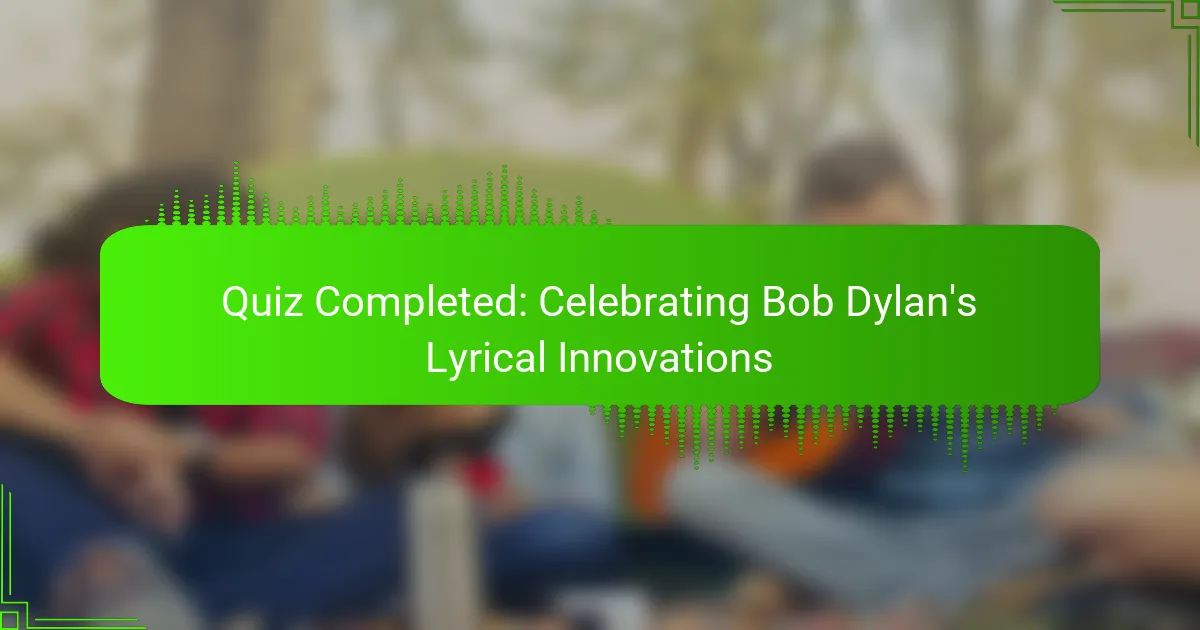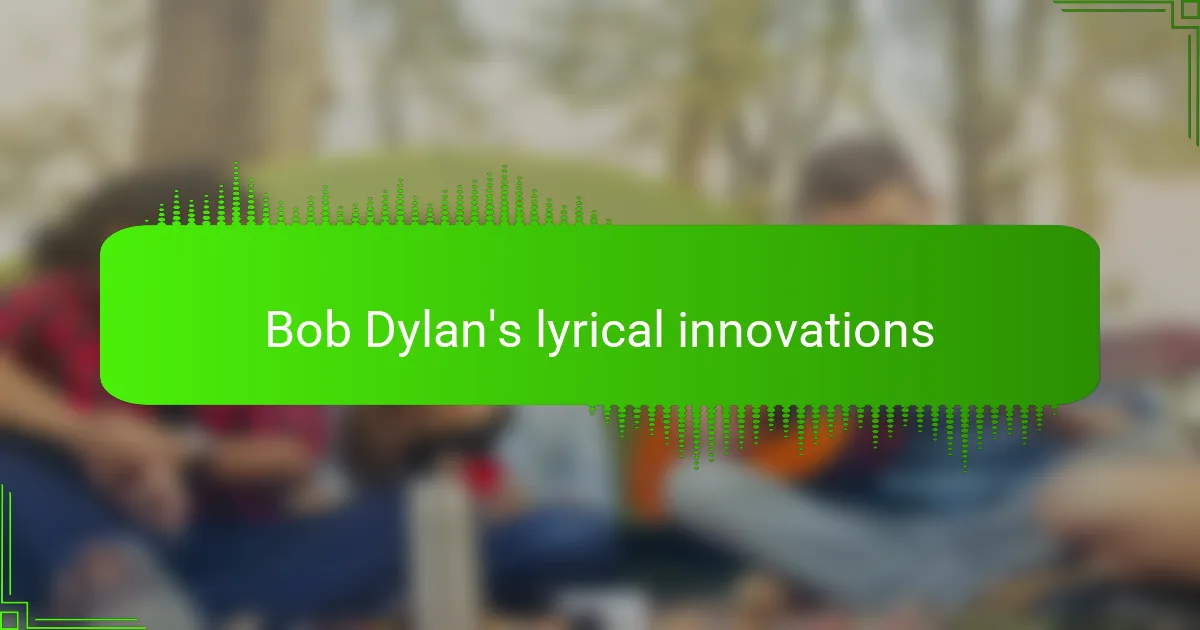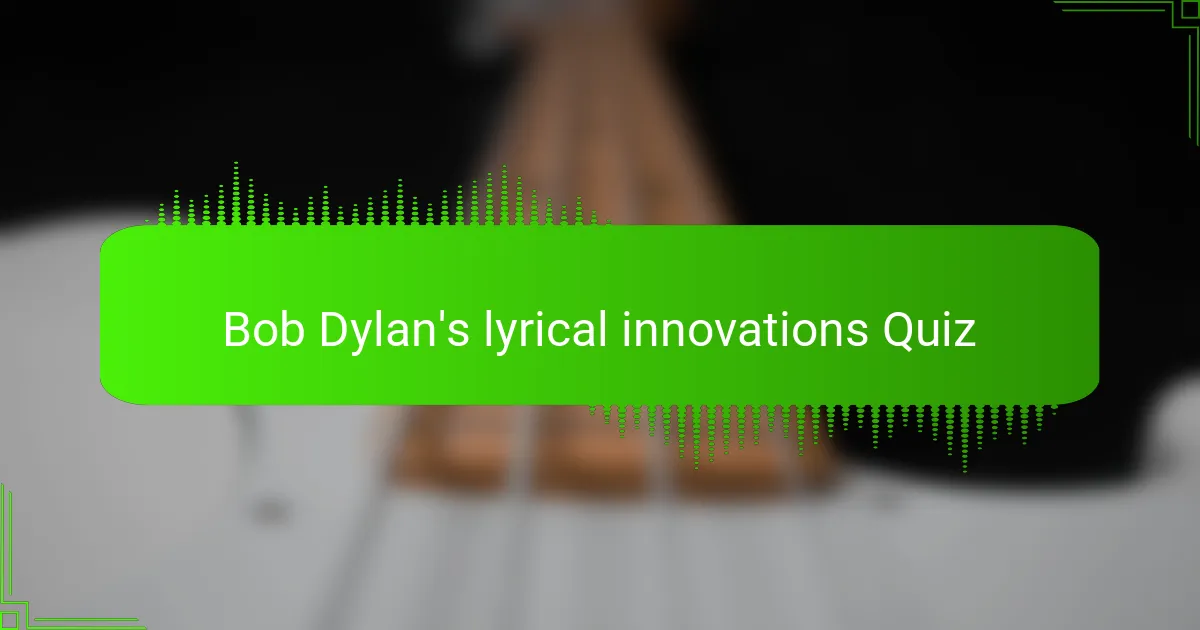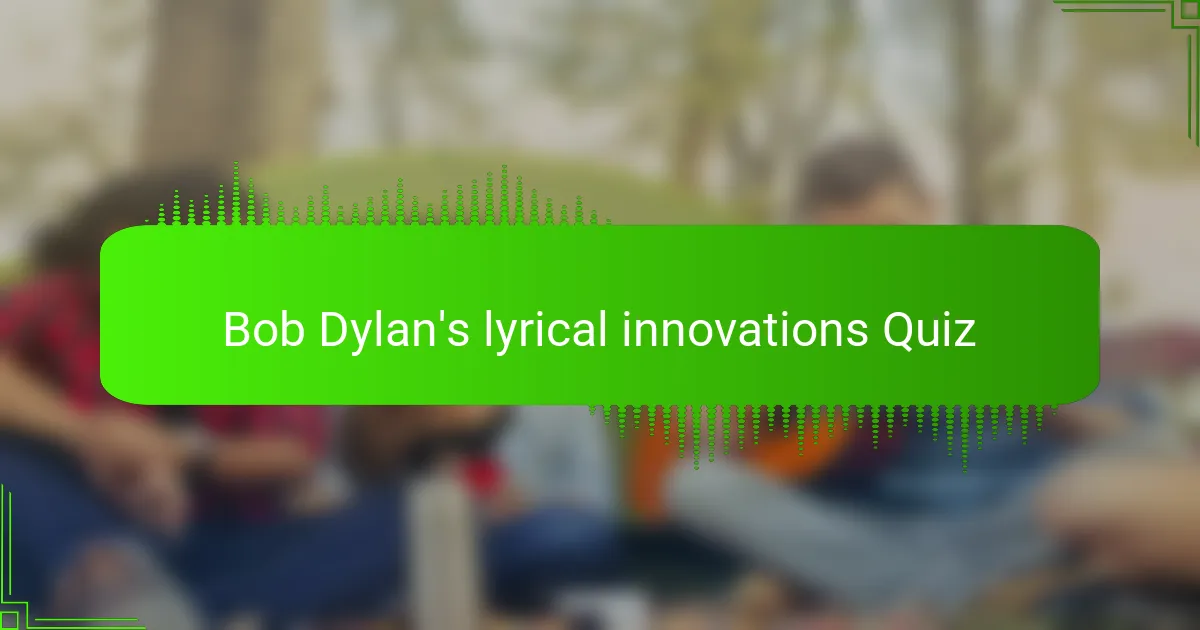
Quiz Completed: Celebrating Bob Dylan’s Lyrical Innovations
Congratulations on completing the quiz about Bob Dylan’s lyrical innovations! We hope you found the experience both engaging and enlightening. Dylan’s work has significantly shaped modern music and songwriting, and exploring his lyrics can reveal deeper meanings and artistic techniques. This quiz was designed to challenge your knowledge while enhancing your appreciation for his craft.
Throughout the quiz, you may have uncovered some fascinating facts about Dylan’s unique styles, themes, and the cultural impacts of his songs. From his storytelling methods to his use of vivid imagery, each question aimed to highlight how his artistry breaks conventional boundaries. It’s clear that Dylan’s innovations continue to resonate, influencing countless musicians and listeners alike.
We invite you to dive deeper into this topic by checking out our next section dedicated to Bob Dylan’s lyrical innovations. There, you’ll find comprehensive insights, analyses, and discussions that will further expand your understanding. Whether you’re a long-time fan or new to his music, there’s always more to discover about this legendary figure in music history.

Bob Dylan’s lyrical innovations
The Evolution of Bob Dylan’s Lyrical Style
Bob Dylan’s lyrical innovations mark a significant evolution in song crafting. Starting with simple folk melodies, his early work, such as “Blowin’ in the Wind,” displayed poignant simplicity and moral depth. As he transitioned through genres, his lyrics increasingly became complex, employing surrealism and vivid imagery. In albums like “Blonde on Blonde,” Dylan’s experimentation with free verse challenged traditional songwriting norms, influencing countless artists. His willingness to incorporate literary techniques expanded the possibilities of lyrical expression in popular music.
Influence of Poetry on Dylan’s Lyrics
Dylan’s background in poetry greatly shaped his lyrical innovations. Drawing from literary giants like Allen Ginsberg and Arthur Rimbaud, his lyrics often reflect a poetic sensibility. Songs such as “Mr. Tambourine Man” utilize metaphorical language and abstract narrative structures, blurring the line between songwriting and poetry. This influence elevated song lyrics to a form of serious art, inspiring subsequent musicians like Leonard Cohen and Patti Smith to adopt a similar approach. Dylan’s work has reaffirmed the value of lyrical depth within the music industry.
Social Commentary and Political Themes
Bob Dylan’s lyrics often serve as powerful social commentary. His protest songs, particularly “The Times They Are a-Changin’,” convey urgent messages about social justice and political upheaval. Dylan’s ability to encapsulate the sentiments of the 1960s counterculture not only garnered widespread appeal but also established a template for politically charged music. Artists like Bruce Springsteen and Joan Baez have followed his lead, using lyrics to address social issues. This innovation transformed popular music into a vehicle for change and dialogue.
The Use of Symbolism and Imagery
Dylan’s innovative use of symbolism and imagery distinguishes his lyrical style. In songs like “Subterranean Homesick Blues,” he blends personal and cultural references, creating layers of meaning. This approach invites listeners to engage with the lyrics on a deeper level, requiring interpretation and reflection. Over time, his work has inspired a range of musicians, urging them to adopt similarly rich lyrical landscapes. Critics often herald Dylan as a master of lyrical symbolism, contributing to a legacy that elevates the medium.
The Impact of Stream-of-Consciousness Technique
Bob Dylan’s incorporation of stream-of-consciousness technique pushed the boundaries of lyrical innovation. In tracks like “Just Like Tom Thumb’s Blues,” he conveys thought processes and emotions in a flowing, unstructured manner. This technique departs from conventional narrative frameworks, offering a more immersive listener experience. Dylan’s influence can be seen in the works of contemporary artists like Fiona Apple and Radiohead, who also experiment with abstract lyricism. His pioneering approach continues to resonate within modern songwriting, cementing his role as a transformative figure in music history.
What are Bob Dylan’s key lyrical innovations?
Bob Dylan’s key lyrical innovations include social commentary, poetic imagery, and non-linear storytelling. His song “Blowin’ in the Wind” uses rhetorical questions to confront issues like civil rights, showcasing his ability to weave profound messages into popular music. Dylan’s unique use of metaphor and symbolism in tracks like “Mr. Tambourine Man” illustrates deeper psychological and existential themes, setting a new standard for lyricism in folk and rock music.
How did Bob Dylan influence other songwriters?
Bob Dylan influenced other songwriters by challenging traditional songwriting structures and incorporating complex themes. Artists such as Leonard Cohen and Neil Young cite Dylan as a pivotal influence. His album “The Freewheelin’ Bob Dylan” introduced narrative songs that delve into personal and political realms, inspiring songwriters to explore deeper emotional and social dimensions in their work.
Where can we see Bob Dylan’s lyrical innovations in his discography?
Bob Dylan’s lyrical innovations are evident in his albums “Highway 61 Revisited” and “Blonde on Blonde.” In these works, he combines surreal imagery with intricate wordplay, as seen in “Like a Rolling Stone.” His exploration of time, identity, and experience creates a rich tapestry of meaning that influenced the direction of modern music and poetry.
When did Bob Dylan’s lyrical style begin to evolve significantly?
Bob Dylan’s lyrical style began to evolve significantly in the mid-1960s, around the time of his release of “Bringing It All Back Home” in 1965. This album marked a departure from traditional folk, shifting toward rock music, while incorporating more surreal and abstract lyrics. The dramatic change in his songwriting is highlighted in songs like “Subterranean Homesick Blues,” which features a rapid, free-associative style that reshaped lyric writing.
Who are some contemporaries that were affected by Bob Dylan’s lyrical style?
Contemporaries affected by Bob Dylan’s lyrical style include Joan Baez, The Beatles, and Bruce Springsteen. Joan Baez was an early collaborator who brought wider attention to his work. The Beatles, particularly in their later albums, incorporated Dylan’s introspective and experimental approach to songwriting. Bruce Springsteen has cited Dylan as a major influence in his narratives about American life and struggles.

